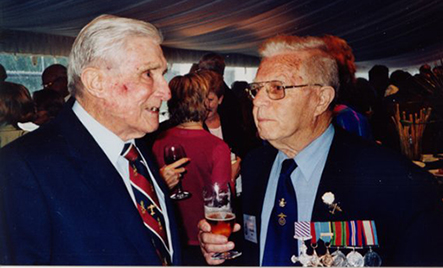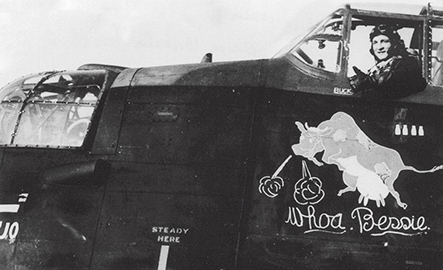G For George and Striking by Night Exhibit Official Opening

G For George and Striking by Night Exhibit

Australian War Museum, Canberra, 5 December 2003
Major General Adrian Clunies–Ross, Chairman, Australian War Memorial Council; Mr Neil Andrew, Speaker of the House of Representatives; Commodore Graham Wiltshire, representing Sir Alastair Goodlad, British High Commissioner; Major General Steve Gower, Director, Australian War Memorial; Members of various ex–services groups; Veterans, especially of Bomber Command and 460 Squadron; Distinguished guests; Ladies and gentlemen.
Good evening, and thank you for inviting me to open this wonderful new exhibit. It’s great to see this historic aircraft once again holding pride of place at the Australian War Memorial – and joined by three of its original Messerschmitt foes!
This wonderful, lucky and revered old Avro Lancaster – which flew an amazing 89 missions at the height of World War II and 76 over Germany – has been meticulously restored over the past five years, at a cost of $1 million.
Not only is it back for everyone to see, but it now serves as the centrepiece of the stunning new Striking By Night audio–visual presentation we’re about to see. The multimedia exhibit will give us a feel for what it was like to take part in a night operation – in this case over Berlin almost 60 years ago to the day.
Ladies and gentlemen.
I must say that, over the years, I’ve personally spent much time imagining just what those brave young airmen saw and felt in the darkest days of the War. As an Army cadet at Duntroon in the mid–1950s, I can clearly remember coming here to peer through the bomb bays of G For George – trying to picture myself as one of the pilots, navigators, bomb–aimers or rear gunners in this huge, lethal machine. Being a crew member of one of these aircraft was a cold, dark, noisy, unpredictable and extremely dangerous job. Copping flak from massive German anti–aircraft barrages, fighting heavily armed enemy planes, seeing mates in your own formation go down in flames, and witnessing the terrible fireworks as your bombs hit the target below – these were just some of the things they experienced.
With bomber formations sometimes including 1000 aircraft, pilots had to be careful not to collide with their colleagues.
Planes had to dodge up to 500 searchlights over Hitler’s industrial heartland of the Ruhr Valley, Hamburg and Berlin – and often an equal number of anti–aircraft guns. As many veterans of those raids over Germany, Italy and other parts of Europe will tell you, service in Bomber Command demanded nerves of steel.


Crews sometimes flew for ten hours straight – and as part of a gruelling schedule of "six weeks on, six days off". If they were lucky enough to survive a raid – and the chances of that became appallingly low – our airmen had time only to count their dead, debrief, prepare for the next raid and perhaps catch some fitful sleep.
Frequently, on return from a mission, a full mess hall would be eerily silent – such was the emotional and physical exhaustion.
As noted earlier, the fatalities suffered by Bomber Command were unimaginably high. 460 Squadron, for example – which operated George – lost 200 planes and 1018 airmen over the course of the war, out of a total of 2730 men who served with the Squadron. A further 200 or so crew were captured as prisoners of war.
Based in Binbrook, Lincolnshire, 460 held records in Bomber Command for the number of trips flown and the tonnage of bombs dropped – but, of course, at an awful cost. Recording some of the highest casualty figures among any Allied units in the War, at one stage the "killed in action" rate reached 85 per cent at the height of the conflict. In 460 Squadron, 45 per cent of the flying component lost their lives in just the first five trips.
A tour of operations was 30 trips, but the life expectancy of a crew was just six – and of the Lancaster itself, only 10. Overall, the 9000 members of the RAAF who served in Bomber Command made a shockingly disproportionate contribution to Australian losses. They represented fewer than 2 per cent of Australian enlistments in all services, but they accounted for nearly 20 per cent of all Australian combat deaths during the War. As one veteran said recently: "We flew until we died or survived. Of course, we must also remember and honour the sterling efforts of the ground crews.
They worked around the clock to patch up these old buses, to load the deadly cargo, to plan missions and do their best to keep the whole show on the road – or in the air! The efforts of Australian and British crews in Bomber Command were extraordinary and heroic. Risking their lives daily, defying almost impossible odds, they played a critical role in destroying German industrial capacity, severely disrupting Hitler’s military operations, and defeating Fascism. In the process, they helped secure the triumph of democracy over dictatorship – the triumph of freedom, tolerance, decency and the rule of law over tyranny. I don’t think it’s an exaggeration to say that we might not be standing here this evening if it weren’t for their clear–eyed vision, resolve and supreme efforts of self–sacrifice.
Ladies and gentlemen.
It’s been an honour to speak with you – at what is essentially the rededication of a national monument to courage and heroism. Tonight, we breathe new life into one of the Memorial’s most popular and enduring exhibits. An exhibit that – in using the best and latest technology – will vividly and realistically tell the story of Bomber Command to successive generations of young Australians. I congratulate everyone who’s been associated with this fine project. And – for the veterans and families of Bomber Command and our overseas friends, in particular – I hope you enjoy tonight’s show and the other commemorative events planned for tomorrow.
It’s now my very great pleasure to officially open the G For George and Striking By Night exhibit.
